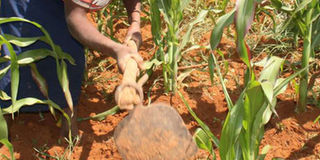New plan to turn around farming in arid areas

Science based research will now be used to boost agriculture and livestock production in arid and semi-arid areas. PHOTO | FILE | NATION MEDIA GROUP
Science based research will now be used to boost agriculture and livestock production in arid and semi-arid areas which are increasingly being exposed to climate change effects.
Devolution and Asals Chief Administrative Secretary Abdul Buhari said for years, the areas have been hit by drought, floods and insecurity negatively affecting, among others, water availability and health. “The Asal regions now have their own department for the first time. Therefore, we will embark on well advised research and come up with the right development programmes for them,” said Buhari.
In 2018, the regions were hit by prolonged drought that severely affected residents and livestock. The drought was immediately followed by heavy rains that triggered flooding. But even before the pastoral communities could enjoy the pasture, swarms of desert locusts came calling.
This cycle, according to scientists, inhibits serious development in the affected areas.
Nearly 83 per cent of the country is ranked either as arid or semi-arid, covering 29 counties and a population of about 16 million people.
While over 90 per cent of the country’s wildlife are also found in Asals, very little resources have been deployed in these regions to stir development. The areas were largely seen as unproductive and insecure until recently when the government created a state department for the Asals.
Climate-related hazards are generally a serious threat to the country’s development, experts say. Agriculture, the country’s mainstay, is predominantly rain-fed, making it highly vulnerable to climate change. Droughts are the most common disasters affecting Kenya while a number of shortfalls in food supply have been associated with rainfall deficits.
“Polices and frameworks have already been identified for this research,” said the CAS. “The stress on natural resources undermines the capacity of nations to govern themselves and increases chances of conflicts.”
RAIN-FED AGRICULTURE
Research shows that climate change can increase the risk of conflict and significantly alter the dynamics of existing conflicts. Loss of livelihoods, water and pasture have triggered cattle rustling and banditry.
Communities in these areas are largely pastoralists who rely on livestock for food and income, but vicious cycles of climate-related disasters have left the residents hopeless and needy.
Loss of livelihoods, water and pasture have triggered cattle rustling, banditry and conflicts in the areas, Mr Buhari said.
A study on Climate Change and Violent Conflicts in East Africa published in 2017 in the International Studies Review indicated that impacts of climate change such as prolonged drought and increased temperatures will inevitably affect the availability of renewable natural resources - crops, pasture, fresh water - which are a commonly invoked conflict driver.
When these environmental changes interact with other pressures on livelihoods — such as political marginalisation or unfair land distribution — groups may become more likely to solve conflicts through violence or to secure resource access by force, the report said.
Climate-related hazards are a generally a serious threat to Kenya’s development, experts said. Agriculture, the mainstay of the economy, is predominantly rain-fed, making it highly vulnerable to climate change. Droughts are the most common disasters affecting Kenya while a number of shortfalls in food supply have been associated with rainfall deficits. "Polices and frameworks have been identified and we will ensure that within the framework that has been drawn will be able to execute that mandate with precision,” said the CAS.
The stresses on natural resources undermine the capacity of nations to govern themselves and increase the chances of conflicts.



